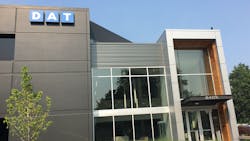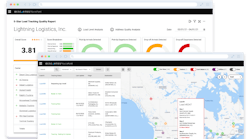Convoy CEO Dan Lewis said the riddle his two-year-old company is trying to solve is pretty straightforward: “How do you get infinitely available capacity and zero waste?” The solution, the former Amazon executive believes, will come from the automation of freight brokerage services and the willingness of truckers to embrace them.
“All of the technology is more or less in place now for this to happen. It’s really a question of how fast can we build trust, how fast can we educate and give people confidence that operating in this way is going to be good for them,” Lewis told Fleet Owner during a visit to the company’s Seattle headquarters. “It’s not that [truckers] all of a sudden woke up and said ‘I’m ready to start using a digital freight broker.’ It is that they started using their smart phones,” he added.
The emergence of companies like Convoy, with backers including Bill Gates and Jeff Bezos, Uber Freight, and others have sparked a race to improve what is considered a highly fragmented and often-times inefficient space.
Executives from established and newer companies had differing views on how radically the landscape will change in the coming years, and even how to best describe what exactly is happening (see sidebar). They did agree, however, that carriers, drivers, and shippers all stand to benefit from the focus on efficiency and visibility.
Rather than a trucker seeking any available load, “all of these systems that we’re building are going to understand what your criteria is, and deliver the loads to you,” said Eileen Hart, vice president of marketing and corporate communications with DAT, the largest load board.
For shippers, “at the end of the day they want the best service they can get,” said Drew McElroy, co-founder and CEO of New York-based start-up Transfix. “It doesn’t necessarily matter to them whether it is a new company or an old company.”
Despite more digital players on the scene, traditional freight brokers have picked up significant market share since the beginning of 2016, said Bob Voltmann, president and CEO of the Transportation Intermediaries Association.
“Carriers are still getting a lot of freight from brokers, and not directly from shippers. We don’t see that changing,” Voltmann said. “Newer companies get a lot of buzz in the press, but the jury is still out which model is going to work.”
Much of that buzz has focused on Uber Freight, which used its ride-sharing platform to develop an app that matches drivers with loads.
“We are firmly at a point that there will be a significant technology shift over next five years,” said Bill Driegert, director of Uber Freight. “We have a significant opportunity to make this a more transparent, efficient, and low-cost process.”
Initially launched in Texas, focusing on moves within a 250-mile range, Uber Freight has since expanded to other densely populated areas on both coasts and the Midwest.
Driegert, formerly chief innovation officer for Coyote Logistics, declined to provide specific shipment figures other than saying “we have grown substantially since the beginning of the year.”
He cited how E*Trade made trading stocks faster and cheaper for the public in describing the role San Francisco-based Uber Freight can play in transportation.
Just over 800 miles to the north, Convoy’s engineers are working to develop technology that will match multiple loads together, come up with a price, and determine how to get the right trucker to immediately accept the job or quickly counter bid via its smart phone app.
“That’s really hard,” Lewis said of trying to completely automate this part of the process. “It is the core of a brokering operation. This is where traditional brokers spend 35 to 40% of their operating costs.”
Days after Fleet Owner’s visit, CNBC broadcasted live from inside the cab of an owner-operator making a delivery of beer from Anheuser-Busch InBev he accepted from Convoy.
In a recorded interview, James Sembrot, Anheuser’s senior director of logistics strategy, spoke highly of its growing relationship with Convoy.
“What we are able to do with a company like Convoy is really use rich contextual data so that we can learn more about our business. For example, we can understand where we are delaying drivers at pickup,” he said. “We also get information about our business that helps us look at pricing a different way.”
After first starting in western Washington state, Convoy now operates in two-thirds of the country, and ships nationwide. Even with about 10,000 carriers signed up, its size is small compared with the more established DAT and Truckstop.com load boards. DAT, which will celebrate its 40th anniversary in 2018, is projecting a record 123 million loads for the current calendar year.
During a visit by Fleet Owner to its new headquarters just outside of Portland, OR, it had a similar, modern feel as Convoy’s office in Seattle. That is a far cry from its humbling beginnings of posting available loads with thumb tacks to bulletin boards at truck stops along the Interstate 5 corridor in the late 1970s.
Through the advent of computers, fax machines, the Internet, and smart phones, there have been no shortages of competitors or challenges, said Hart, the company’s vice president of marketing and corporate communications.
Even as she credited newer players for creating excitement and “challenging everyone in the industry,” there is one crucial element they are lacking.
“In dealing with fragmented marketplaces, having critical mass [of shippers and truckers] is the single most important thing,” she said. “Young upstarts’ biggest challenge is to have enough freight in their systems.”
The phrase “critical mass” was also used by Trent Broberg, general manager of Truckstop.com, in outlining the uphill battle start-ups face.
Founded in 1995 as the first Internet load board, Truckstop.com is posting up to 6,000 loads a day, “levels we have never seen before,” he said.
It isn’t just the total number of loads that illustrates just how important these services are for truckers, he said.
About 70% of the drivers accessing Truckstop.com are using it “as the primary source of freight,” which shows it is more than just a place to turn “as a last resort.”
He noted many owner-operators and small fleets use more than five sites for finding loads, a sign of just how fragmented the industry remains.
“There is so much freight out there and so many variables for the driving community that they want that flexibility to make decisions,” Broberg said.
That suggests many companies will find varying levels of success, including some of competitive start-ups that have brokerage authority and are customers of DAT and Truckstop.com.
While all of that freight may entice more companies into the market, automation is only a piece of the overall equation, warned TIA’s Voltmann.
“All the data indicates shippers want an engaging relationship with 3PLs – and that is not electronic,” he said.
Voltmann warned truckers against going along with the idea that “every truck is the same” and using automated load boards “as your primary source” for freight.
“Motor carriers need to build relationships with their brokers - not the other way around,” Voltmann said.
While recognizing the importance of those relationships, Lance Healy, co-founder of Banyan Technology, offered an example where automation can provide new benefits.
A truck often has a little extra room available, and a trucker could be alerted while on delivery to several pallets waiting to be picked up nearby. That provides the trucker an easy way to earn additional money while already on a delivery, Healy said.
Convoy’s Lewis took issue with Voltmann’s comments, saying many of the person-to-person conversations involve negotiating a rate or determining why a delivery is late. He added Convoy has customer relations and customer service personnel to build relationships and solve problems.
“We are 100% sure the technology won’t work 100% of the time,” Lewis admitted.
Uber Freight’s Driegert also pushed back, stating “drivers have not been well served by the current model.”
Owner-operators in particular “don’t always get the price they expected,” and services like Uber Freight can help provide them a more instantaneous and secure transaction, he suggested.
McElroy, the CEO of Transfix, is another proponent of the need to change the brokerage market. He had spent most of his life in his family’s brokerage business prior to founding his own logistics software firm in 2013.
“We believe logistics is changing,” said McElroy, whose company made waves this summer after raising an additional $42 million in financing. “We have seen it coming and right now it is happening in front of our eyes. I find it very exciting.”
McElroy stressed the company’s efforts to reduce empty miles, cut the time looking for a load, and speed transactions through data analysis, real-time visibility and exception management.
“We can tell people things about their supply chains that most people are not thinking about today,” he said.
Transfix also touts fast payments to truckers as a way to attract their interest. Earlier this year, it launched an online booking marketplace and added functionality for rate negotiations.
One company that has backed into the load board arena is Trucker Path.
The company initially made its mark offering real-time parking and amenities information at truck stops nationwide through its free smart phone app.
As its popularity grew, the company then launched its load board, and now sees about 3.5 million postings each month, said Leigh Foxall, vice president of business development.
“From a technology standpoint, [the industry] is very far behind meeting the challenges drivers have when they are out on America’s highways,” she said. That is why Trucker Path will continue to emphasize the importance of “smart phones as a tool to be successful.”
Beyond these companies, there are dozens of others seeking their own market niches, as well as the possibility of Amazon moving into this space.
Peter Rentschler, managing partner with consulting firm CarrierDirect, had words of caution for all sides.
“There are dozens of start-ups in the start-up graveyard that have tried to build platforms for shippers and carriers,” he said.
But that does not give the green light for fleets to ignore what is transpiring. It is critical they stay on top of developments, and make sure their own systems are up to date.
“We are a few years away from a real winner being declared,” he said of the changing landscape. “The reality is carriers are shooting themselves in the foot if they refuse to get involved in the discussion.”
‘Uberization’ of Freight? Many take issue with that terminology
As greater levels of technology and automation take hold in the freight brokerage and load board space, the phenomenon has often been referred to as the “Uberization of freight.”
But is that an accurate way to describe what is unfolding?
“It is flattering, and speaks to the impact Uber has had in the expectations for service in the ride-sharing space,” Bill Driegert, director of Uber Freight, said. “People want to be able to have that level of service and simplicity. What it means is this is more than just freight matching.”
Dan Lewis, CEO of Convoy, has observed numerous technology start-ups lumped into the “Uberization wrapper,” though he considers the term “misleading.” That phrase suggests there are on-demand trucks waiting nearby for an urgent pickup, which is not really an accurate description, he said. Even as Lewis tried to define “digital freight matching” in clearer terms, he joked that “we need to come up with a better name.”
Bob Voltmann, president and CEO of the Transportation Intermediaries Association, was more blunt in his assessment, calling the term “totally inaccurate.” He praised Uber for simplifying a taxi system that often meant standing out in the cold and hoping one would stop.
“When it comes to trucking and brokerage and freight, that’s not what is going to happen,” he said. “A box standing on the loading dock doesn’t wait for a truck to go by.”
He continued: “What they are talking about is an attempt to reduce the number of touches to move a specific load.”
Lance Healy, co-founder and president of Banyan Technology, shared with Fleet Owner what he viewed as an interesting takeaway from a recent panel discussion.
A logistics executive also on the panel said Uber’s ride-sharing idea was crafted out of the existing logistics industry, and there is nothing from that service the logistics industry does not already utilize as Uber enters the freight space.
Despite that fact, Healy, whose company has been electronically linking clients and fleets for 16 years, is “delighting in this continued evolution of carriers and shippers connecting together.”
Trent Broberg, general manager of Truckstop.com, also downplayed the terminology. “The idea of ‘Uberization’ has been around for 20-plus years,” he said. “We have been doing this at a very foundational level for a long time.”
Likewise, Sam Bokher, director of marketing at Trucker Path, pointed out that there have been on-demand freight systems in trucking long before Uber came on the scene.
There is so much fragmentation and a lack of visibility within trucking that there is no real central place for shippers and truckers to meet, as there is in Uber’s ride-sharing model, Bokher said.
Regardless of however it is exactly described, Drew McElroy, co-founder and CEO of Transfix, offered a different perspective. It shows a new crop of technology companies “have moved the ball forward,” he said. “It is a good thing. The more the industry realizes the legitimacy of what we are doing, the faster it can move forward.”






